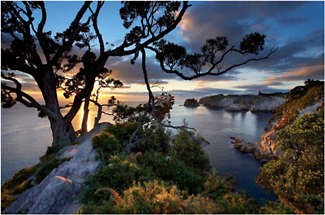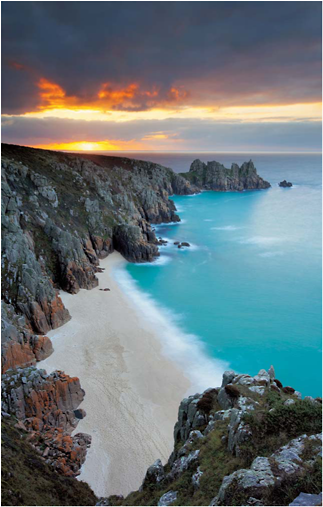
Dawn on the beach at Bamburgh Castle, Northumbria, England
I reckon I’ve seen more sunrises than I’ve had hot dinners, but this one takes the biscuit. Standing by the tripod at dawn in the middle of a two- minute exposure I’m marvelling at the colours rippling through the sky and reflecting off the wet sand. A surf is rolling in off the North Sea and Bamburgh Castle stands commandingly overlooking the beach, silhouetted by the first light spreading through the wisps of cloud in unbelievable hues of pink and purple. The novelty of this experience never wanes, even after 25 years of dawn patrols. Last night high winds shattered our tent and we ended up sharing with complete strangers in theirs. To the mystery couple from York, thanks very much; hope we didn’t wake you when we crept out at 5am for the dawn light. We’d conquered the wilds of Patagonia but came unstuck in Northumberland – all part of life’s rich pageant.
• Fuji GX617, 90mm lens
Water
In a village outside Zhongdian, high on the Tibetan plateau in China’s Yunnan Province, the kids were playing up for the camera. They may never lay eyes on a distant ocean. For many of us that seems inconceivable. Our connection with the sea is wound into our identity and permeates our lives. We are all inescapably drawn to it, for our leisure, our work, or just to gaze endlessly at its ever-changing moods. For us photographers that is doubly true. The coast has an inescapable draw.
Photographically the possibilities are endless. I could spend my whole career shooting the sea, quite happily. What’s more it’s accessible, at least if you don’t live in Zhongdian. It’s easy to stroll along the coastal path and shoot some dramatic images, right? It’s safe, anyone can do it. Well, in all my travels the only times I’ve ever been in peril have been when I’ve been a fool and underestimated the power of the seemingly benign sea. I came within an inch of drowning in Tahiti, trying to wade between two islands. A French jet-skier picked me up. I’ve been caught by the wave from the Perfect Storm on the north Cornish coast, picked up and tossed with all my gear on to the

Anse Severe, La Digue, Seychelles
To find the perfect palm tree stretched across the perfect white sand beach I searched tropical islands right around the globe in a two-year quest. It was tough but someone had to do it. I’ve never taken the job of location finding to such extremes. I found my Holy Grail here on La Digue in the Seychelles, which is possibly one of the most beautiful tropical islands in the world, located in the middle of the Indian Ocean. I’m here now, writing this book about half a mile from that beach. The tree is no more I’m afraid, but at least that means this picture can never be repeated.
• Fuji GX617, 105mm lens

Sunrise at Te Pare Point, near Hahei, Coromandel Peninsula, North Island, New Zealand
There’s clarity to the light here in New Zealand that’s unique. Perhaps it’s due to the absence of an ozone layer over Aotearoa, but it makes for some sparkling photographic conditions. We’ve had another 3.40am rise this morning, a 40-minute drive, followed by an hour’s hike, or tramp as they say in these parts, and now we’re in position as the rising sun bathes the bays and cliffs of the Coromandel Peninsula. We scouted this location yesterday and now all the elements have come together beautifully – Mother Nature likes us this morning. I’m pondering how I’m going to make this image, both here and back at base. My working methods have evolved over the last few years as I’ve partially switched to shooting digitally, and this morning’s high-contrast scene will require all the flexibility the new medium gives me. The sensitivity of the sensor, the exposure latitude of the RAW file and the scope for skilled and sensitive processing make a digital camera an incredibly versatile tool.
• Canon EOS-1Ds MKII, 17–40mm lens

Weary Bay at dawn, Queensland, Australia
Tracing the names up the east coast of Australia, you get a good indication of Captain James Cook’s state of mind as the Endeavour sailed north on his voyage of discovery in 1769. Just out to sea here, off Queensland’s Cape Tribulation, they struck the coral reef and almost foundered. After temporarily plugging the breach in the hull with canvas the crew towed the stricken Endeavour with oar power across this bay in search of shelter to effect repairs. I love salty stories like that, and have to admit Cook is a hero of mine. I’m on the pier of a rainforest lodge at dawn, breaking all the compositional rules again. It’s a long exposure, and I manage just a couple of bracketed exposures while the fire in the sky lasts. It’s a beautiful sight in a tranquil location, but a worm is turning inside of me; I’m concerned I haven’t made enough strong images yet on this trip. It’s the constant photographer’s angst, which can only be relieved temporarily with another productive photosession. Sooner rather than later, it returns.
• Nikon F5, 17–35mm lens

Portland Bill at dusk, Dorset, England
Off this point is the Race, a meeting of currents creating some truly evil seas. Normally in winter this spot is being battered by monster waves: it’s the graveyard of many ships and cameras. This afternoon the sea is like a millpond and the sky a leaden grey; I almost abandon my watch, but decide to hang on a bit longer. So many times I’ve given up prematurely and headed for dinner, only to curse myself bitterly as a final burst of light of the day taunts me. I’m rewarded as a flicker of gold ignites the rocks. I’m scrabbling to take a meter reading and expose while the light lasts. The sea is so calm I’m concerned the scene will lack the usual drama this location provides, but the quality of the light more than makes up for it.
• Fuji GX617, 90mm lens
rocks like a piece of flotsam. It hurt. And I’ve been cut off by the tide in Scotland, only to be saved by International Rescue in the form of my wife paddling out to retrieve me in a rowboat in the dark. I suspect I’ve not heard the last of that one. And I’ve lost many cameras and lenses to the effects of salt water.
Why does all this keep happening? Well, apart from me being an idiot there are two mitigating circumstances. Firstly, and I’m sure it’s true for all of us, when I’m working on an image I get totally absorbed, the rest of the world ceases to exist. Time passes; I often think I’ve been crouching by the tripod for ten minutes when it turns out to be more like an hour. And secondly, the best images are made when you go for the boldest composition, and that means getting the tripod legs wet. You’re not going to make a knockout picture from the car park.
Keeping your kit dry is one of the biggest challenges here, and there are waterproof covers made for cameras, which, while not protecting from a monster wave, will keep the worst of the spray off. Of course that doesn’t actually include the front lens element or filter, as this by definition must be exposed. So between exposures a soft, dry lens cloth is needed to remove all the salty moisture steadily adding diffusion to your image, whether you want it or not.

Wild flowers on the cliffs of the Lizard, Cornwall, England
It’s late spring in Cornwall and the cliff tops on the Lizard are bursting with colour. I’m feeling alternative this morning and make a shot with no sky, concentrating just on the wild flowers and craggy coast. Maybe I’m biased, but I think we’re lucky in the British Isles to have some of the most varied and dramatic coastlines anywhere.
• Fuji GX617, 90mm lens
Using long exposures with moving water is hardly a new idea, but it’s one we’re all hooked on; it gives a dreamy, ethereal look and I’ve spent many hours standing with water lapping around my feet waiting to finish another six-minute exposure. To slow exposures down neutral density filters are crucial: I regularly use a 0.6 or 0.9 ND, which equates to +2 or 3 stops of exposure. On larger format cameras with tiny minimum apertures like f/45 and slow ISO 50 film, long exposures are almost obligatory, but with digital cameras it’s often difficult to slow exposures enough. With default sensitivities of ISO 100 or faster and minimum apertures of only f/22, exposures longer than a second can be difficult to achieve even with ND filters. Using two in conjunction helps, but they must good filters – both optically and in terms of colour quality – otherwise sharpness will suffer and gruesome colour casts become apparent. I use two Lee 0.9 ND glass filters made especially for digital cameras. The amount of movement desirable is for you to decide. An exposure of 1/2sec on a breaking wave will give a pleasing blurry drama, while an eight-minute exposure at dusk transforms the water into a sea of mercury. Again, do trials, experiment. And above all, know what the tide is doing – is it ebbing or flowing? Check the tide times, wear wellies, and rinse the tripod down with fresh water afterwards to prevent it rusting and clogging up with salt.
“The best images are made when you go for the boldest composition, and that means getting the tripod legs wet”

Porthcurno, Cornwall, England
As the sun rises over the Lizard streaks of fire arc through the dawn sky. A 0.9 graduated neutral density filter holds back the exposure on the sky, whilst a 0.9 neutral density filter allows me to slow the exposure to 25 seconds to record some motion blur of the waves breaking on the beach. I expose a test frame, check my highlight alerts and histogram, dial in +0.3 exposure compensation with aperture priority matrix-metering, and start exposing.
• Canon EOS-1Ds mkII, 16–35mm lens)
